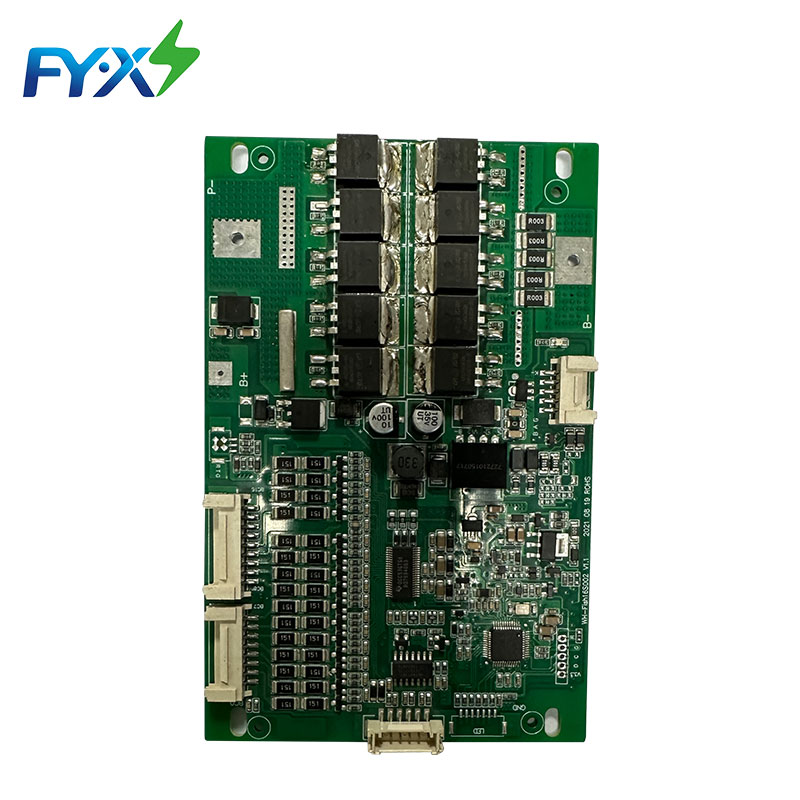Considerations for BMS for Automated Guided Vehicles
2024-06-04
A Battery Management System (BMS) for an Automated Guided Vehicle (AGV) is a critical component that oversees the health, performance, and safety of the vehicle's battery pack. AGVs are mobile robots used in various industries for material handling, logistics, and transportation tasks. Here's an overview of the BMS for an AGV, including its functions, features, importance, considerations, and benefits:
Functions of BMS for Automated Guided Vehicles:
1. Cell Monitoring:
- Monitors the voltage, temperature, and state of charge of individual battery cells within the pack to ensure balanced charging and discharging.
2. State of Charge (SoC) Estimation:
- Estimates the remaining capacity of the battery pack to provide accurate information on the available energy for operation.
3. Temperature Management:
- Controls the temperature of the battery pack by monitoring cell temperatures and activating cooling or heating systems as needed to maintain optimal operating conditions.
4. Cell Balancing:
- Balances the charge levels of individual cells within the battery pack to prevent overcharging or overdischarging and maximize the overall pack capacity.
5. Safety Monitoring:
- Detects and responds to abnormal conditions such as overvoltage, undervoltage, overcurrent, and overheating to prevent damage to the battery pack and ensure safe operation.
6. Fault Detection and Diagnostics:
- Identifies and diagnoses faults or malfunctions in the battery system, allowing for timely maintenance and troubleshooting to minimize downtime.
7. Communication Interface:
- Provides communication capabilities to interface with the AGV's control system for real-time monitoring, data logging, and remote diagnostics.
Features of BMS for Automated Guided Vehicles:
1. Scalability:
- Designed to accommodate different battery chemistries, voltages, and capacities, making it suitable for a wide range of AGV applications.
2. Real-Time Monitoring:
- Provides real-time monitoring and feedback on battery performance and health, enabling proactive maintenance and optimization of battery usage.
3. Adaptive Algorithms:
- Utilizes adaptive algorithms and control strategies to optimize battery charging and discharging processes based on operating conditions and usage patterns.
4. Integration Capabilities:
- Compatible with various communication protocols and interfaces, allowing seamless integration with the AGV's control system and other monitoring devices.
5. Modular Design:
- Features a modular design that allows for easy installation, maintenance, and expansion of the BMS as needed to accommodate changes in battery configuration or system requirements.
6. Safety Compliance:
- Compliant with relevant safety standards and regulations governing battery systems to ensure safe operation and prevent potential hazards.
Importance of BMS for Automated Guided Vehicles:
1. Optimized Performance:
- Ensures optimal performance and efficiency of the AGV by monitoring and controlling the battery system to maximize energy usage and extend battery life.
2. Safety Assurance:
- Enhances safety by preventing overcharging, overdischarging, and other potentially hazardous conditions that could lead to battery damage, fire, or electrical hazards.
3. Reliability and Availability:
- Improves reliability and availability of AGV operations by minimizing unplanned downtime due to battery-related issues and enabling predictive maintenance based on real-time diagnostics.
4. Cost Savings:
- Reduces operational costs by extending battery life, minimizing energy consumption, and avoiding costly repairs or replacements resulting from improper battery management.
5. Compliance Requirements:
- Helps AGV manufacturers and operators meet regulatory and safety compliance requirements related to battery systems and electrical equipment.
Considerations for BMS for Automated Guided Vehicles:
1. Battery Chemistry:
- Select a BMS that is compatible with the specific chemistry and characteristics of the battery pack used in the AGV, whether it's lithium-ion, lead-acid, or another type.
2. System Integration:
- Ensure seamless integration with the AGV's control system and other monitoring devices to enable effective communication and coordination of battery management functions.
3. Operating Environment:
- Consider the operating environment and conditions in which the AGV will be deployed, including temperature extremes, vibration, and exposure to dust or moisture, to select a BMS with suitable environmental protection and ruggedness.
4. Scalability and Flexibility:
- Choose a BMS that can scale and adapt to changes in battery configuration, system requirements, and operational needs over time to accommodate future upgrades or expansions.
5. User Interface and Data Visualization:
- Look for BMS solutions with user-friendly interfaces and data visualization capabilities to facilitate monitoring, diagnostics, and analysis of battery performance and health.
Benefits of BMS for Automated Guided Vehicles:
1. Enhanced Battery Life:
- Optimizes battery performance and extends battery life by preventing degradation, imbalance, and damage caused by improper charging or discharging.
2. Improved Safety:
- Enhances safety for operators, equipment, and facilities by minimizing risks associated with battery-related hazards such as overcharging, overheating, or short circuits.
3. Increased Efficiency:
- Maximizes energy efficiency and operational uptime by ensuring optimal use of battery capacity and resources, leading to improved productivity and cost savings.
4. Predictive Maintenance:
- Enables predictive maintenance and proactive troubleshooting based on real-time monitoring and diagnostics, reducing downtime and maintenance costs associated with battery failures or malfunctions.
5. Compliance Assurance:
- Helps AGV manufacturers and operators meet regulatory and safety compliance requirements related to battery management and electrical systems, ensuring legal compliance and liability protection.
Conclusion:
A Battery Management System (BMS) is a critical component of an Automated Guided Vehicle (AGV) that oversees the health, performance, and safety of the vehicle's battery system. By monitoring and controlling key parameters such as voltage, temperature, state of charge, and safety conditions, the BMS ensures optimal battery performance, reliability, and safety throughout the AGV's operation. Selecting the right BMS for an AGV involves considerations such as compatibility with battery chemistry, system integration, operating environment, scalability, and user interface requirements. Ultimately, a well-designed and properly implemented BMS provides numerous benefits, including enhanced battery life, improved safety, increased efficiency, predictive maintenance capabilities, and compliance assurance for AGV operations.



